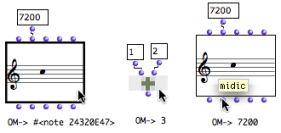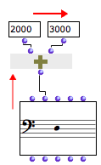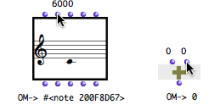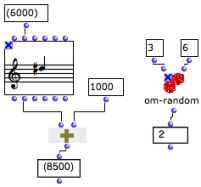Evaluation
Evaluating a box means calling its inner function and parameters. If this box is connected to others, all the upstream boxes will be evaluated one by one. Thus, evaluating one box can trigger a more or less lengthy evaluation chain. This chain refers to the calculus of a function tree, or, in other words, of the visual program.
Evaluating boxes and outlets
 |
In any case, the whole box, that is all of its outputs, are computed during the evaluation. |
Computation Flow : Left-Right, Bottom-Up
In a program, a box evaluates all boxes connected to its inputs, and evaluates its inputs from left to right . Therefore, the evaluation of a patch always goes bottom-top and left right , graphically speaking. |  |
Default Values
 | Box inlets have a default value. This is why a box can generally be evaluated even if part or the totality of its inlets are not connected to another box. Default values can be visualized by hovering the mouse over an inlet. |
Locking / Unlocking a Box
 Locked boxes : the values of the locked boxes are fixed and do not depend on the box inputs anymore. | To lock a box, select it and press
To unlock the box, press |
Several other evaluation modes can be used for controlling the transmission of resulting data in a program, or to perform specific tasks.
